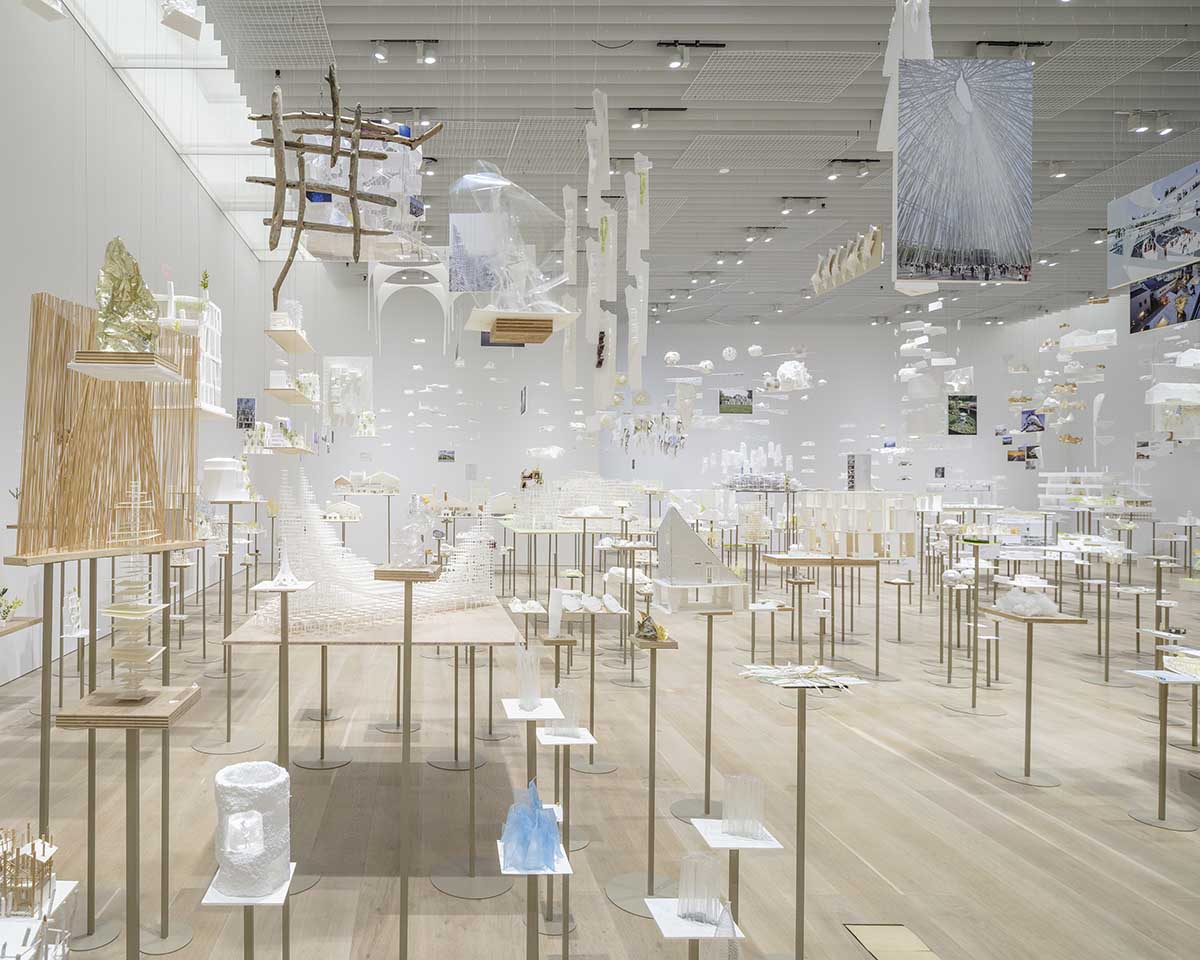
Japanese architect Sou Fujimoto has opened a new exhibition at the Mori Art Museum in Tokyo, Japan.
The exhibition, titled The Architecture of Sou Fujimoto: Primordial Future Forest, is on display from Wednesday, July 2, to Sunday, November 9, 2025 at the Mori Art Museum.
This exhibition represents the first major survey of Fujimoto’s work. The show offers a thorough overview in eight sections, covering everything from his early work to ongoing projects, tracking his architectural journey over the last thirty years, the characteristics of his architecture, and the underlying philosophy.

Forest of Thoughts. Model of 117 projects, study materials, Inkjet print, and others. Dimensions variable. Collection: SHIMIZU CORPORATION (Tokyo) (The Grand Ring for Expo 2025 Osaka, Kansai 1:50 scale model), The Museum of Modern Art, New York (Architecture is everywhere, copy is on view in this exhibition). Image © Yashiro Tetsuya, courtesy of Mori Art Museum, Tokyo
By combining exhibits like installations, large-scale models that offer a spatial experience, and a mock-up, it capitalizes on the venue’s expertise as a contemporary art museum, enabling anyone, not just those involved in architecture, to physically experience the essence of Fujimoto’s oeuvre.
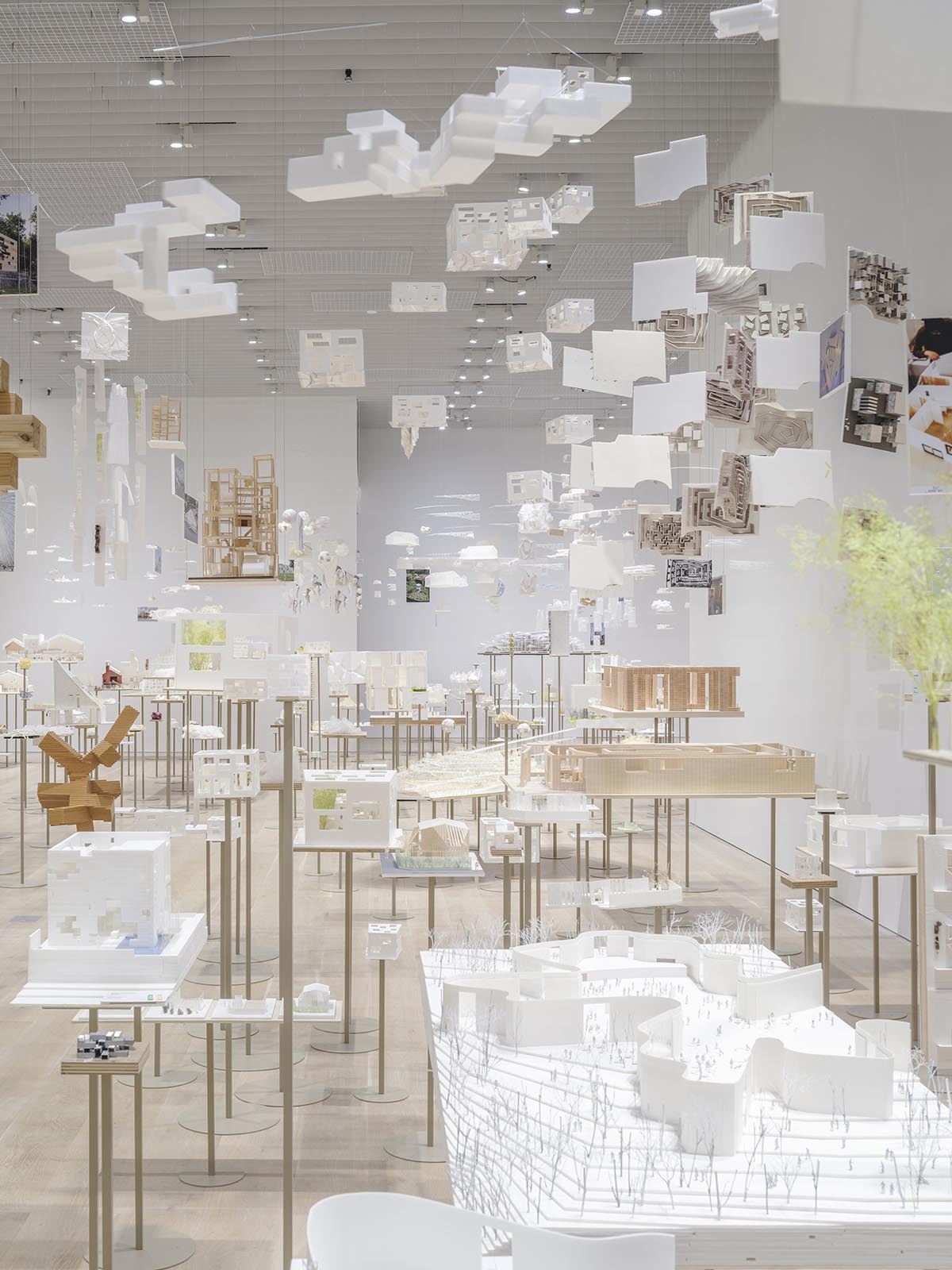
Forest of Thoughts. Model of 117 projects, study materials, Inkjet print, and others. Dimensions variable. Collection: SHIMIZU CORPORATION (Tokyo) (The Grand Ring for Expo 2025 Osaka, Kansai 1:50 scale model), The Museum of Modern Art, New York (Architecture is everywhere, copy is on view in this exhibition). Image © Yashiro Tetsuya, courtesy of Mori Art Museum, Tokyo
These enhance traditional displays such as scale models, blueprints, and pictures of finished constructions. Through Fujimoto’s concept of the future metropolis, the exhibition also examines the function and possibilities of architecture.
Today, architecture and cities are expected to play a larger role than in the past due to the constantly shifting relationships between people and their lives, which are influenced by technological advancements. This includes taking into account the environment and serving as a link between disparate communities.

Forest of Thoughts. Model of 117 projects, study materials, Inkjet print, and others. Dimensions variable. Collection: SHIMIZU CORPORATION (Tokyo) (The Grand Ring for Expo 2025 Osaka, Kansai 1:50 scale model), The Museum of Modern Art, New York (Architecture is everywhere, copy is on view in this exhibition). Image © Yashiro Tetsuya, courtesy of Mori Art Museum, Tokyo
The Mori Art Museum invites visitors to join us as visitors use Fujimoto’s work as a framework to think about how architecture may transform our lives in these difficult times.
For Fujimoto, who was raised in Higashikagura, a verdant village close to Asahikawa in Hokkaido Prefecture, the densely forested environment of Hokkaido represents the ideal setting.
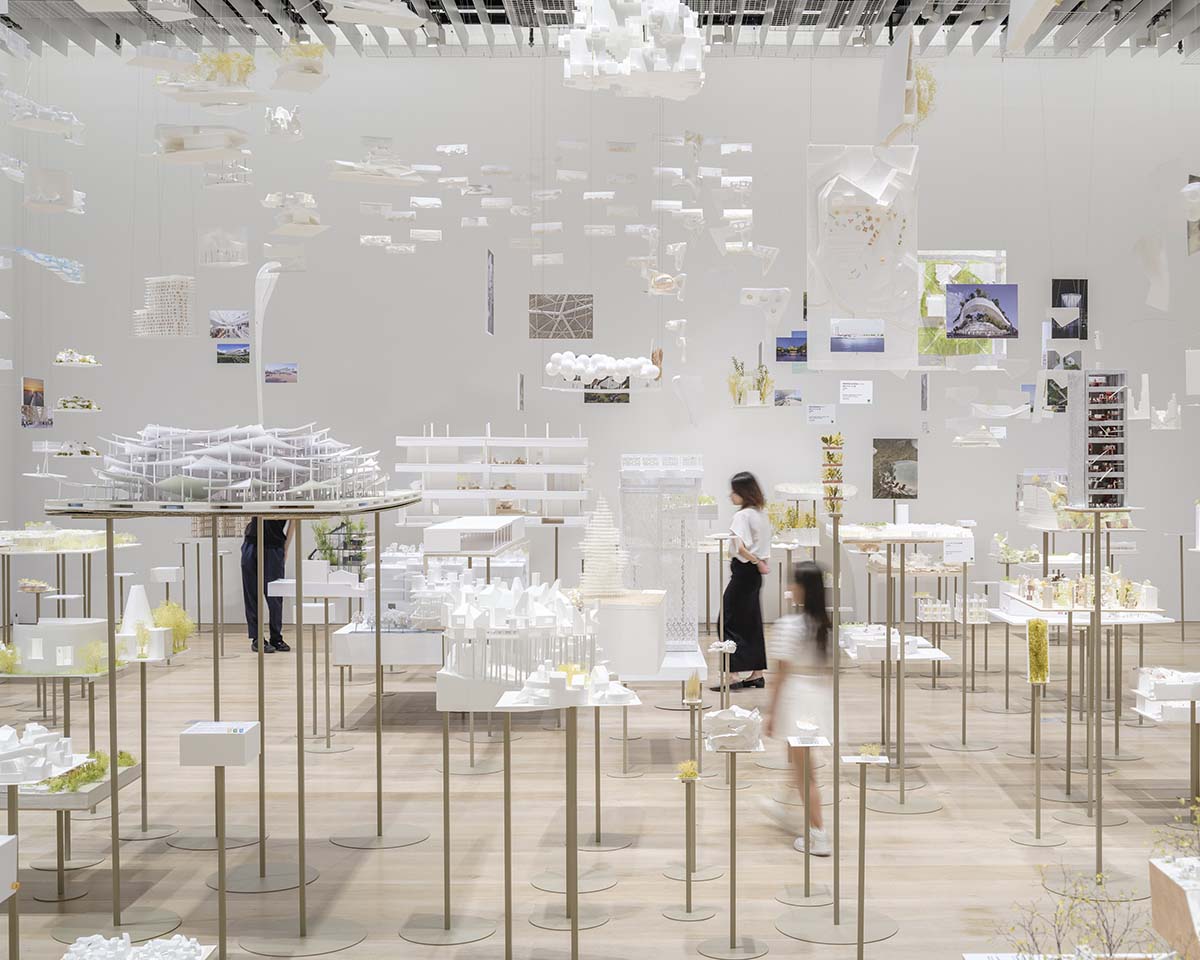
Forest of Thoughts. Model of 117 projects, study materials, Inkjet print, and others. Dimensions variable. Collection: SHIMIZU CORPORATION (Tokyo) (The Grand Ring for Expo 2025 Osaka, Kansai 1:50 scale model), The Museum of Modern Art, New York (Architecture is everywhere, copy is on view in this exhibition). Image © Yashiro Tetsuya, courtesy of Mori Art Museum, Tokyo
He finds aspects of the forest there as well, observing “a similar loose order amid the confusion” of the intricate road system in a large city like Tokyo and circumstances where a wide range of items coexist.
The city, with its tiny objects like flowerpots, bicycles, and billboards lining alleyways, and the forest, with its tiny branches and leaves, are both on a human scale.
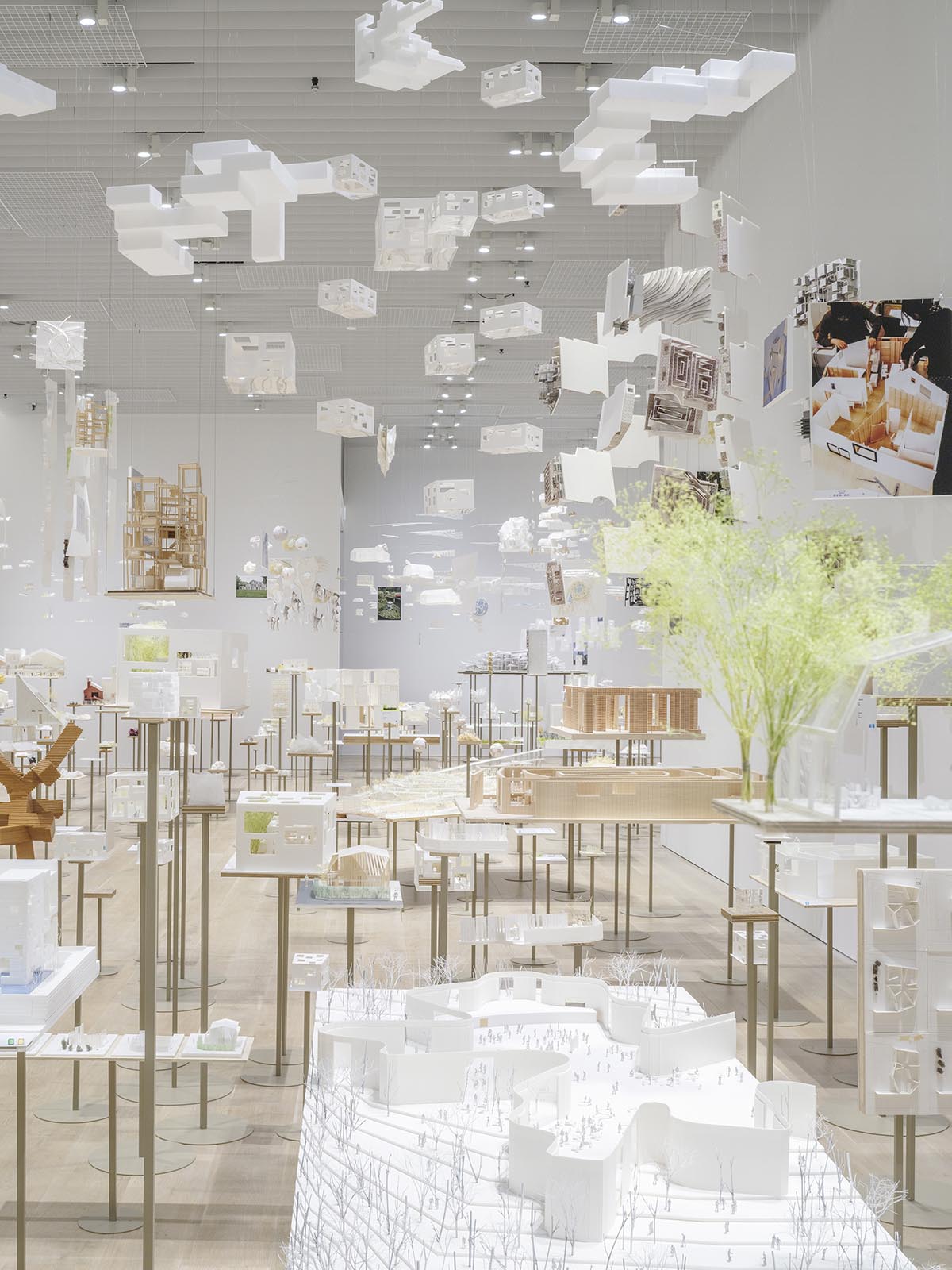
Forest of Thoughts. Model of 117 projects, study materials, Inkjet print, and others. Dimensions variable. Collection: SHIMIZU CORPORATION (Tokyo) (The Grand Ring for Expo 2025 Osaka, Kansai 1:50 scale model), The Museum of Modern Art, New York (Architecture is everywhere, copy is on view in this exhibition). Image © Yashiro Tetsuya, courtesy of Mori Art Museum, Tokyo
Both cities and forests are multilayered environments where life emerges and experience the cycle of life and death. However, woods are ancient, having existed long before humans.
One of the main elements of Fujimoto’s creative process is the idea of the forest, which appears in his work in a variety of ways during the course of his career.

Forest of Thoughts. Model of 117 projects, study materials, Inkjet print, and others. Dimensions variable. Collection: SHIMIZU CORPORATION (Tokyo) (The Grand Ring for Expo 2025 Osaka, Kansai 1:50 scale model), The Museum of Modern Art, New York (Architecture is everywhere, copy is on view in this exhibition). Image © Yashiro Tetsuya, courtesy of Mori Art Museum, Tokyo
According to Fujimoto, this idea will serve as a paradigm for both building and society in the future. Inspired by that idea, the exhibition’s title, “Primordial Future Forest,” combines the words primordial and future.
Fujimoto’s first major survey show, presenting a the past around thirty years of major projects
Architect Toyo Ito and other prominent figures praised the then-unknown Fujimoto for his 2000 submission of The Aomori Museum of Art Design Competition Proposal.
He was unexpectedly thrown onto the architectural spotlight after winning second place. The Serpentine Gallery Pavilion 2013, which is made up of white steel poles assembled into a three-dimensional, latticed structure, the L’Arbre Blanc (The White Tree), a housing complex with large balconies that resemble leaves spreading out from a tree, and the House of Music Hungary, a music-focused cultural complex that blends in with the park’s greenery, are just a few of the notable projects he went on to design.

Section 5: Open Circle. The Architecture of Sou Fujimoto: Primordial Future Forest, Mori Art Museum, Tokyo, 2025. Image © Yashiro Tetsuya, courtesy of Mori Art Museum, Tokyo
He is now working on several projects, such as designing mixed-use urban complexes in Europe and the International Center Station Northern Area Complex in Sendai, Japan, which is expected to be finished in 2031. In eight sections, this survey exhibition provides an overview of his architectural career over the last thirty years, encompassing everything from early work to ongoing projects.

The Grand Ring for Expo 2025 Osaka, Kansai 1:5 scale model, 2025 (Wood and metal). Image © Yashiro Tetsuya, courtesy of Mori Art Museum, Tokyo
The Grand Ring for Expo 2025 Osaka, Kansai, Japan appears throughout the exhibition
The Grand Ring project, which has come to represent Expo 2025 Osaka, Kansai, Japan, is shown in the show. Fujimoto is the Expo’s Site Design Producer.
The 1:5 model of a portion of the Ring, photographs of its exterior, project materials from the Ring’s conception to its completion, and a model of the Ring included in the expansive Forest of Thoughts (2025) installation are just a few of the ways this exhibition focuses on the Ring concept throughout the galleries.

Forest of Thoughts. Model of 117 projects, study materials, Inkjet print, and others. Dimensions variable. Collection: SHIMIZU CORPORATION (Tokyo) (The Grand Ring for Expo 2025 Osaka, Kansai 1:50 scale model), The Museum of Modern Art, New York (Architecture is everywhere, copy is on view in this exhibition). Image © Yashiro Tetsuya, courtesy of Mori Art Museum, Tokyo
Structure of the exhibition
1. Forest of Thoughts
More than 100 of Fujimoto’s projects, from early work to current ones, are displayed in this installation. Three genealogies are at the heart of Fujimoto’s architecture: “open boundaries” that should be closed but are open to the outside; “amorphous”—the way spaces are invariably ambiguous and equivocal in their nature and purpose; and “many many many”—the myriad parts that go into any single building. All of these elements are arranged chronologically in a vast area of more than 300 square meters.
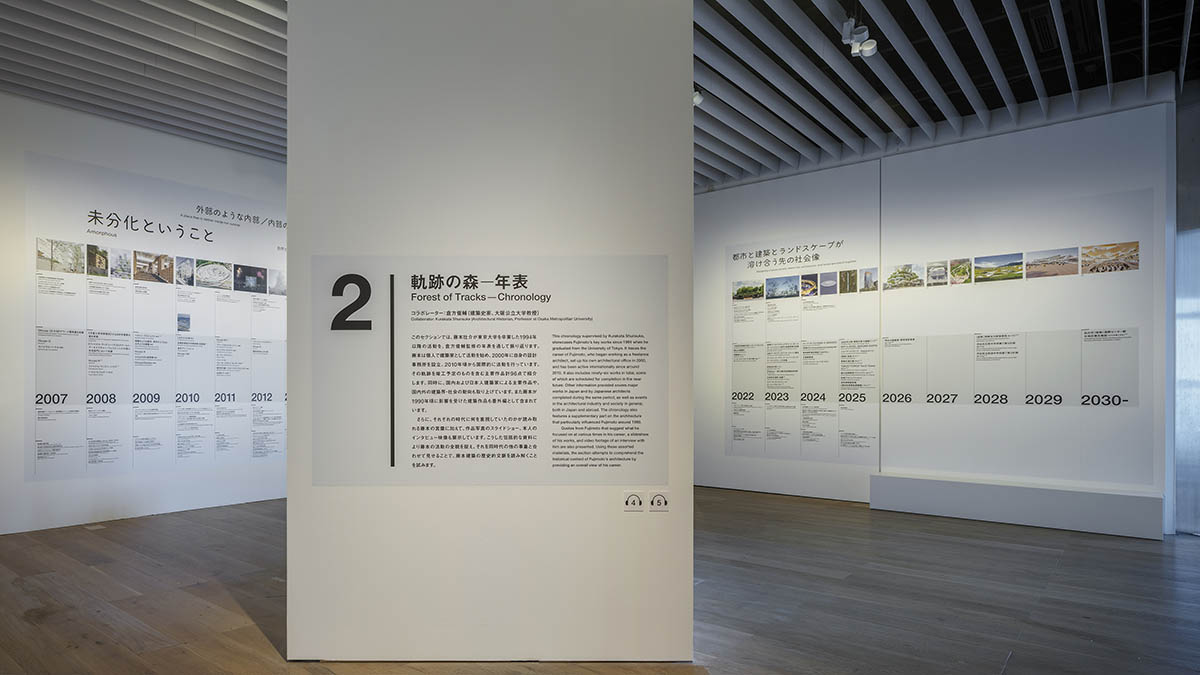
Section 2: Forest of Tracks – Chronology. The Architecture of Sou Fujimoto: Primordial Future Forest, Mori Art Museum, Tokyo, 2025. Image © Yashiro Tetsuya, courtesy of Mori Art Museum, Tokyo
2. Forest of Tracks – Chronology
This exhibit, which was created under Kurakata Shunsuke’s supervision, offers a timeline of Fujimoto’s career. It includes the 96 projects he has worked on since earning his degree from the University of Tokyo in 1994, including those that are currently in the planning stages.
This chronology contains significant structures in Japan and by Japanese architects finished during the same period, as well as architectural and societal milestones in Japan and around the world, to help understand the historical context of Fujimoto’s architecture. This section also features a slideshow of Fujimoto’s architectural images, video footage of an interview with him, and quotations and sayings from Fujimoto that illustrate his focus at different points in his career.
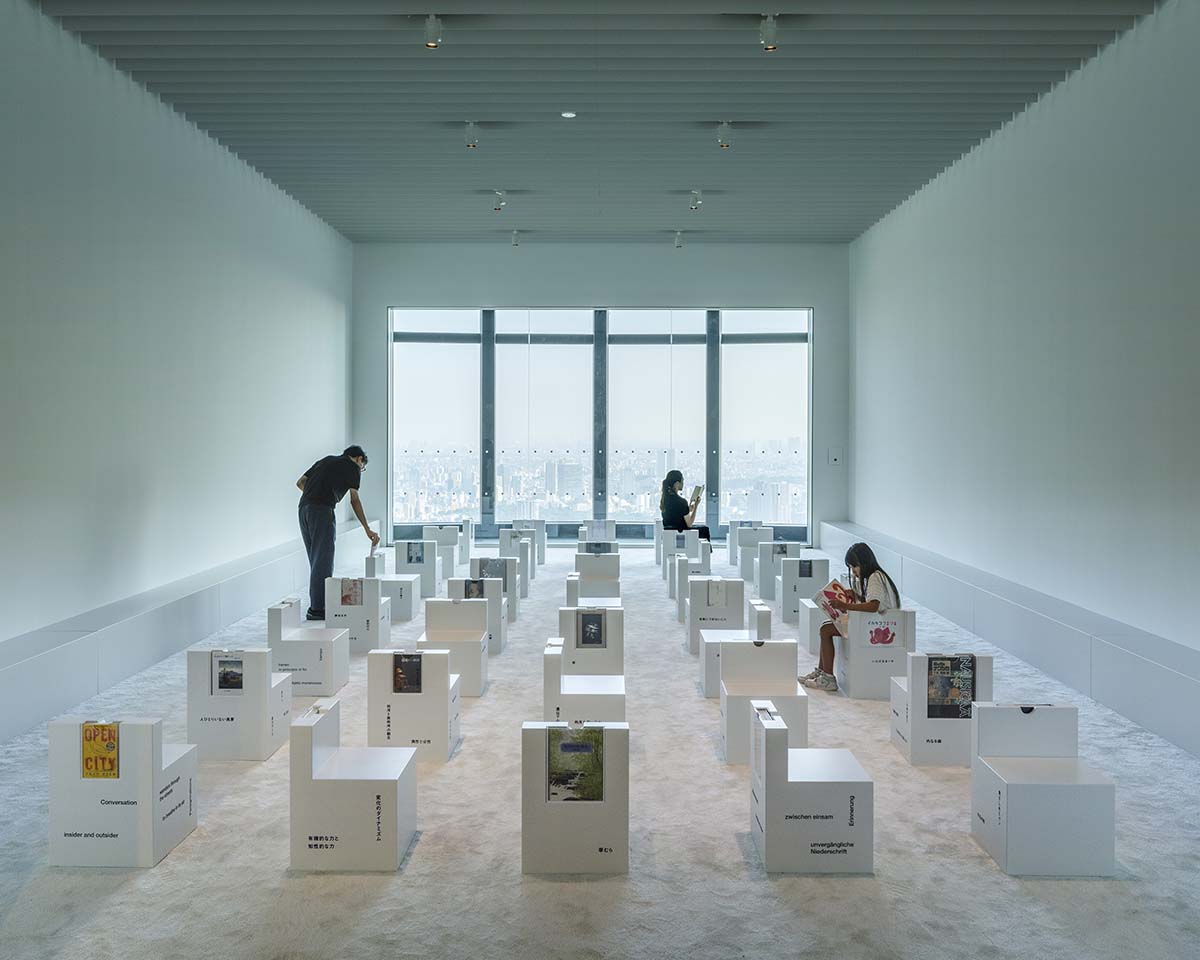
Section 3: Book Lounge of Awai (In-Between). The Architecture of Sou Fujimoto: Primordial Future Forest, Mori Art Museum, Tokyo, 2025. Image © Yashiro Tetsuya, courtesy of Mori Art Museum, Tokyo
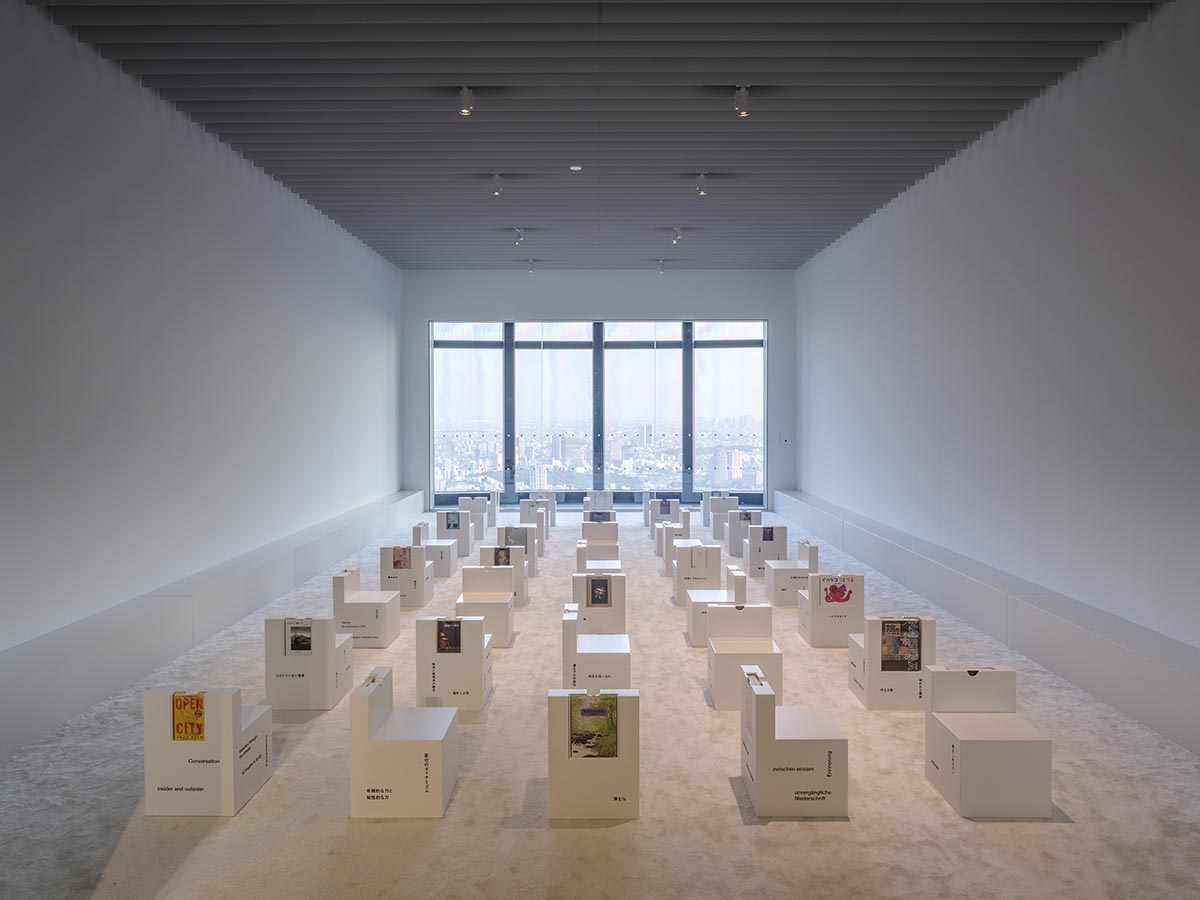
Section 3: Book Lounge of Awai (In-Between). The Architecture of Sou Fujimoto: Primordial Future Forest, Mori Art Museum, Tokyo, 2025. Image © Yashiro Tetsuya, courtesy of Mori Art Museum, Tokyo
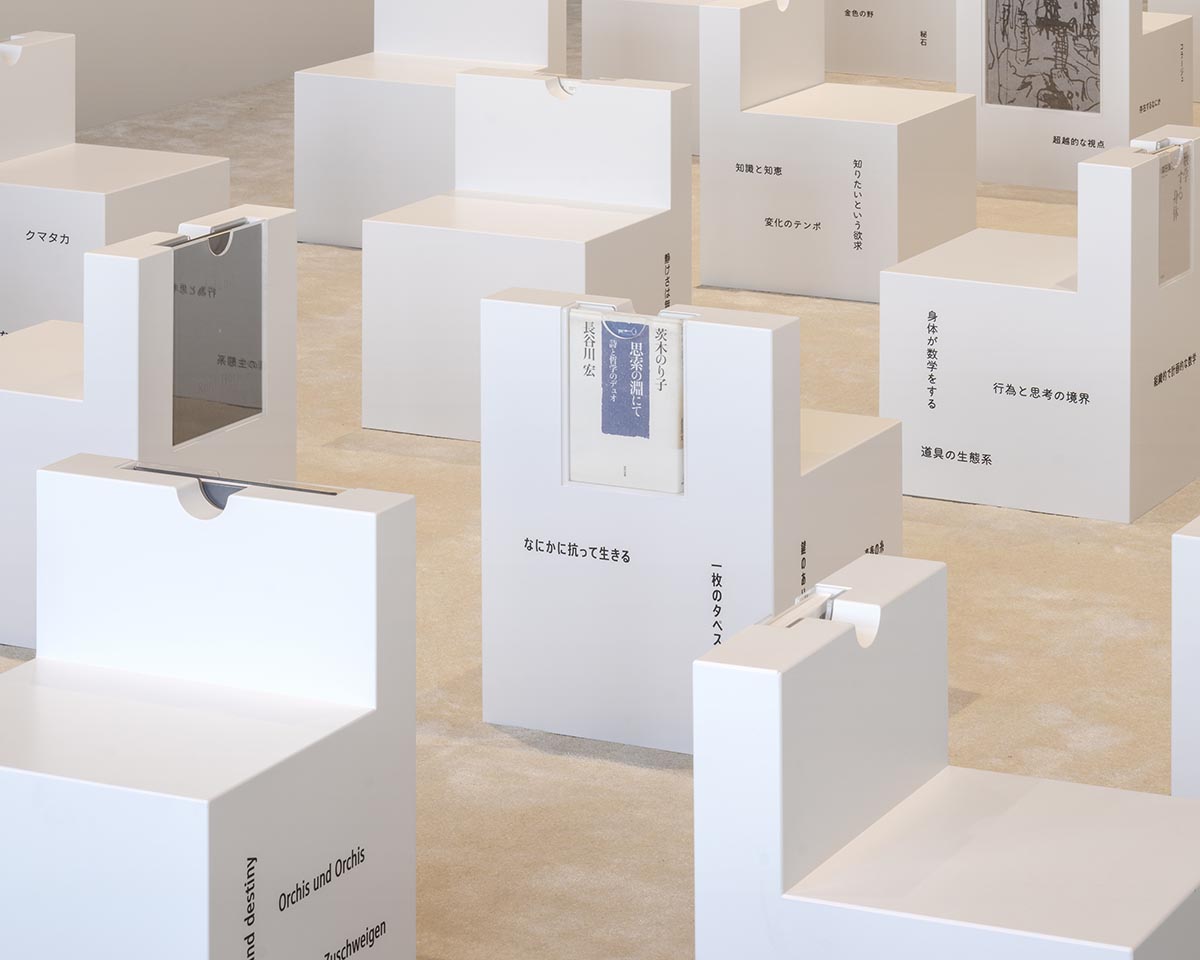
Section 3: Book Lounge of Awai (In-Between). The Architecture of Sou Fujimoto: Primordial Future Forest, Mori Art Museum, Tokyo, 2025. Image © Yashiro Tetsuya, courtesy of Mori Art Museum, Tokyo
3. Book Lounge of Awai (In-Between)
This book lounge, which is based on the idea of Awai (In-Between), is situated in a gallery area with windows that provide a view of the surrounding city. It includes forty novels grouped into the five themes of “Forest Nature and the City,” “Chaos and Order,” “Memories of the Earth,” “Overlapping Voices,” and “Uncompleted Landscapes,” which were chosen by Haba Yoshitaka for their resonance with Fujimoto’s architecture.
Every book is positioned on a seat that shows passages from the book to give an idea of what it is about. Perhaps torn between reading and not reading, visitors might lose themselves in the written word or take a moment to relax and take in the cityscape, which Fujimoto has frequently compared to a forest.
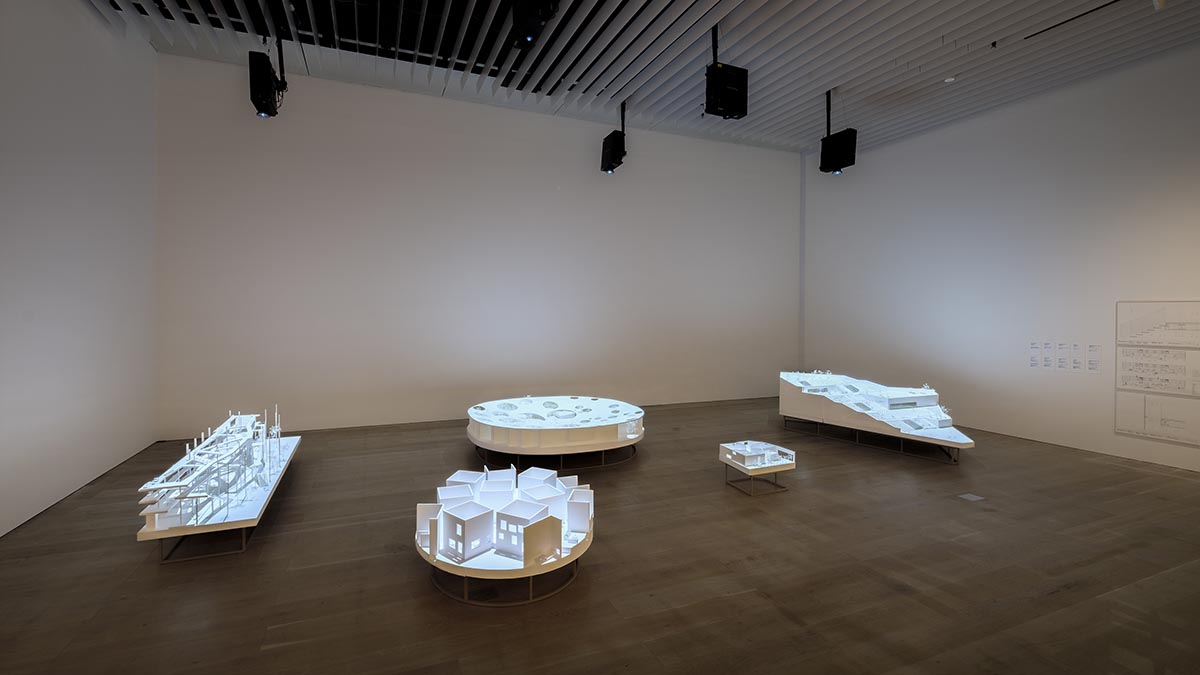
Section 4: The Animated Forest. The Architecture of Sou Fujimoto: Primordial Future Forest, Mori Art Museum, Tokyo, 2025. Image © Yashiro Tetsuya, courtesy of Mori Art Museum, Tokyo

Section 4: The Animated Forest. The Architecture of Sou Fujimoto: Primordial Future Forest, Mori Art Museum, Tokyo, 2025. Image © Yashiro Tetsuya, courtesy of Mori Art Museum, Tokyo
4. The Animated Forest
In this show, models of buildings are exhibited with animation that depicts the motions of people and building users. This section introduces five projects with accompanying architectural drawings, with the intention of focusing on people’s movements rather than architecture itself.
These projects include UNIQLO PARK (2020, Kanagawa, Japan), a paradise for kids who scramble joyfully over its slopes and other features, T house (2005, Gunma, Japan), which connects family members while allowing them to be apart, and BEM Baʻtiment d’Enseignements Mutualise—a New Learning Center for Polytechnic University (2023, Saclay, France).
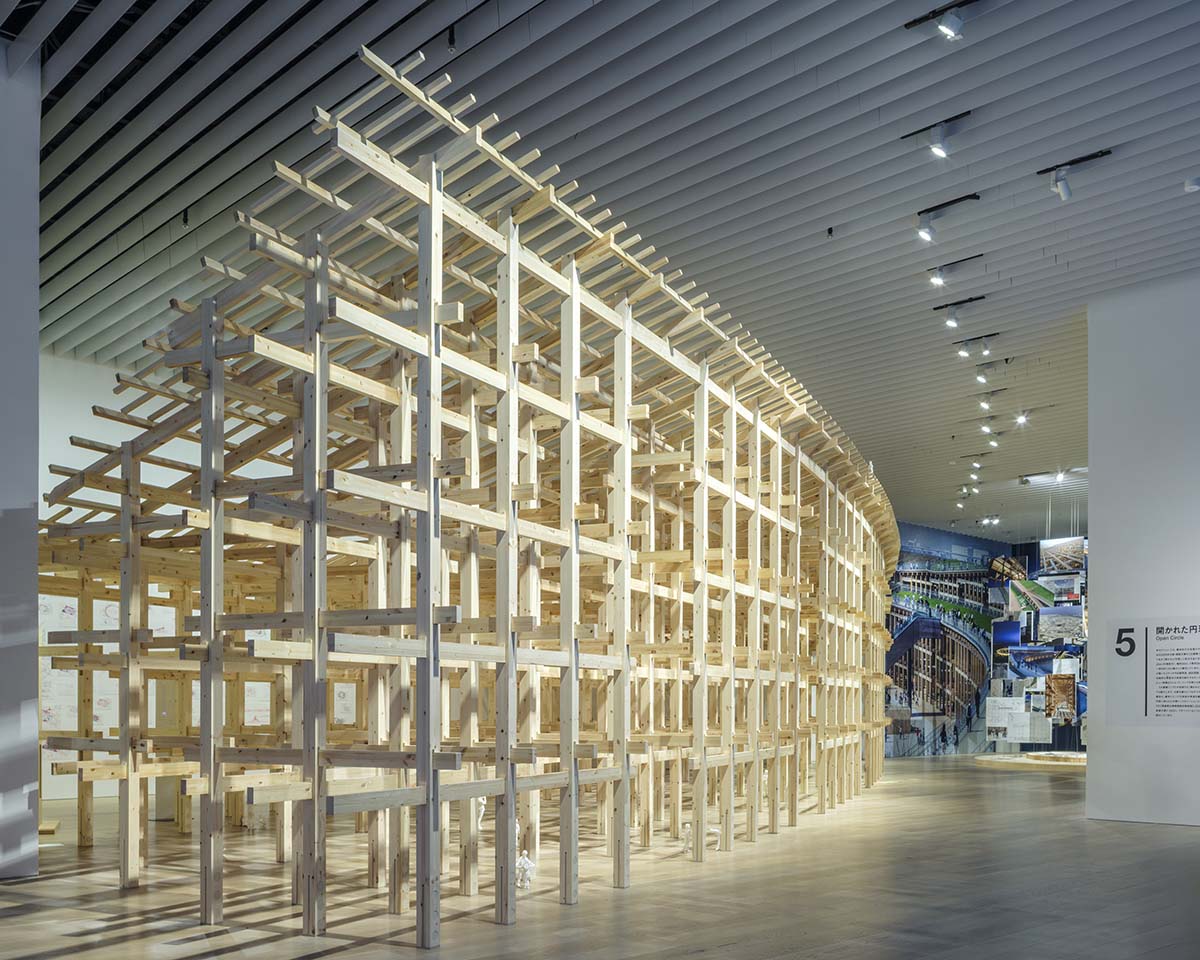
Section 5: Open Circle. The Architecture of Sou Fujimoto: Primordial Future Forest, Mori Art Museum, Tokyo, 2025. Image © Yashiro Tetsuya, courtesy of Mori Art Museum, Tokyo
5. Open Circle
This exhibit examines the Grand Ring from a number of angles, including concept stage sketches, documentation photos, a mock-up showcasing the traditional Japanese nuki column-beam joinery used in the Ring, and video footage of an interview with Fujimoto.
It features an over-four-meter-tall 1:5 scale model of a portion of The Grand Ring for Expo 2025 Osaka, Kansai (2025), the Expo’s focal point and the largest wooden structure in the world.
In addition to models of the House of Music Hungary and eleven other projects that reflect the same idea, the exhibit focuses on the idea of an open circle that, in Fujimoto’s worldview, serves as a metaphor for bonds that transcend division due to its contrasting centripetal and divergent qualities.
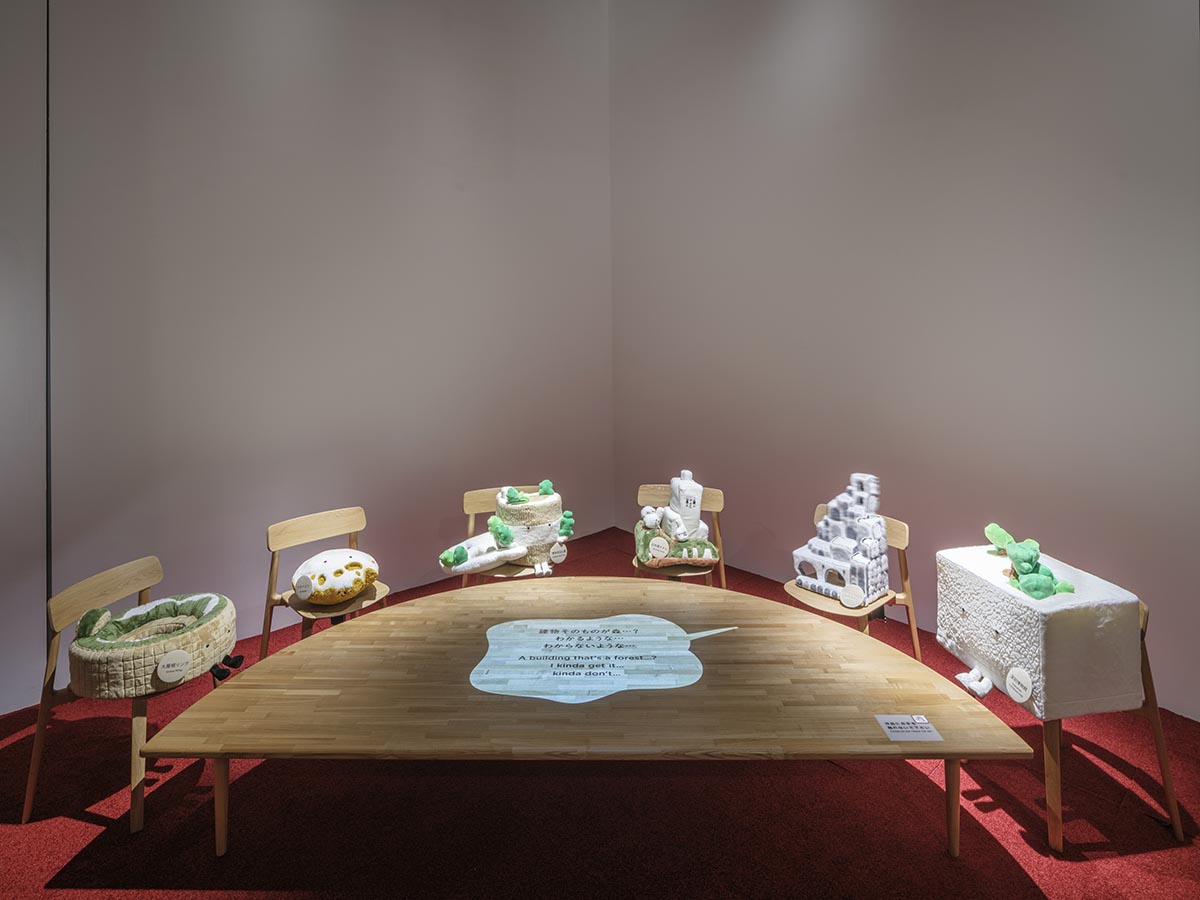
Section 6: Stuffed Architecture Talks. The Architecture of Sou Fujimoto: Primordial Future Forest, Mori Art Museum, Tokyo, 2025. Image © Yashiro Tetsuya, courtesy of Mori Art Museum, Tokyo
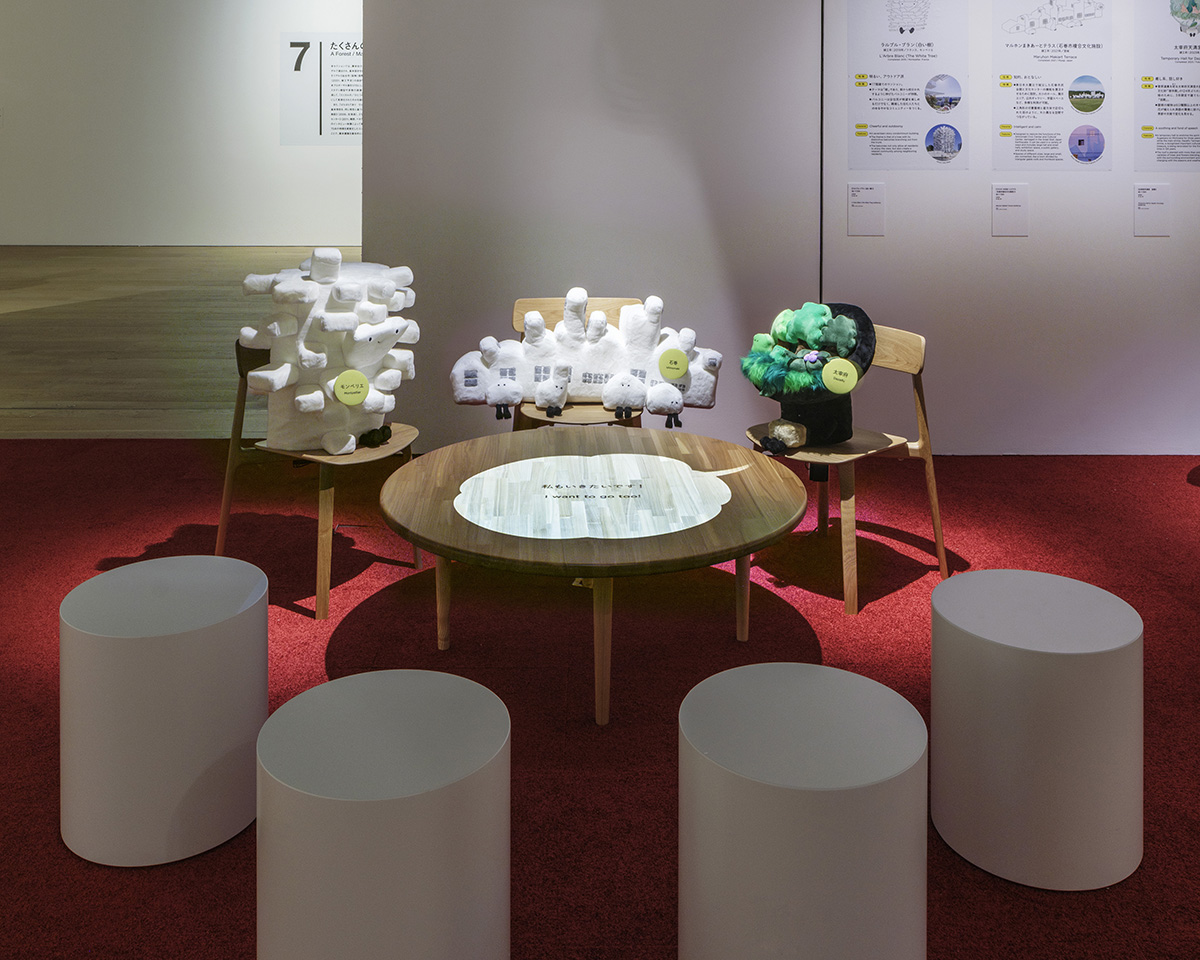
Section 6: Stuffed Architecture Talks. The Architecture of Sou Fujimoto: Primordial Future Forest, Mori Art Museum, Tokyo, 2025. Image © Yashiro Tetsuya, courtesy of Mori Art Museum, Tokyo
6. Stuffed Architecture Talks
This project depicts nine of Fujimoto’s architectural creations, such as L’Arbre Blanc (The White Tree) and the Temporary Hall for the Dazaifu Tenmangu (2023, Fukuoka, Japan), as talking plush toys. Each of the toys has an own personality, such as being happy and gregarious or silent and somber, and they all have amusing opinions about each other’s architectural designs.
Their discussions shed light on the features of each project as well as the environments in which they originated. There are numerous drawings from Fujimoto in this part as well.

Section 7: A Forest / Many Forests. The Architecture of Sou Fujimoto: Primordial Future Forest, Mori Art Museum, Tokyo, 2025. Image © Yashiro Tetsuya, courtesy of Mori Art Museum, Tokyo
7. A Forest / Many Forests
In 2024, a competition chose Fujimoto’s design for the International Center Station Northern Area building (Sendai), a multipurpose building that will include music halls and act as an earthquake memorial. Along with research models and other materials that show how the idea of “many/one echo(es)” was given tangible form during the design process, this exhibit features a large 1:15 scale suspended model of the winning design that allows spectators to appreciate its structure.
The exhibit is further enhanced by project models that represent Fujimoto’s idea of “diverse and unified,” together with pertinent film footage of an interview with Fujimoto and concept sketches of his seventy main projects, to help provide a thorough knowledge of his architecture.
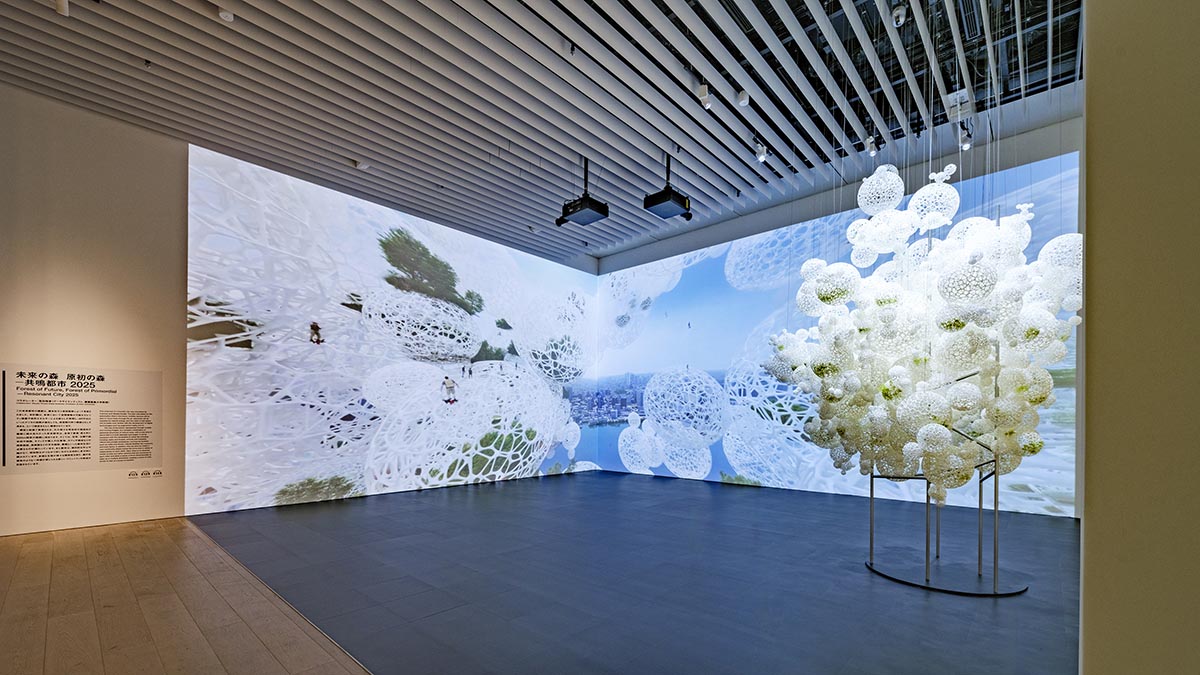
Section 8: Forest of Future, Forest of Primordial – Resonant City 2025. The Architecture of Sou Fujimoto: Primordial Future Forest, Mori Art Museum, Tokyo, 2025. Image © Yashiro Tetsuya, courtesy of Mori Art Museum, Tokyo
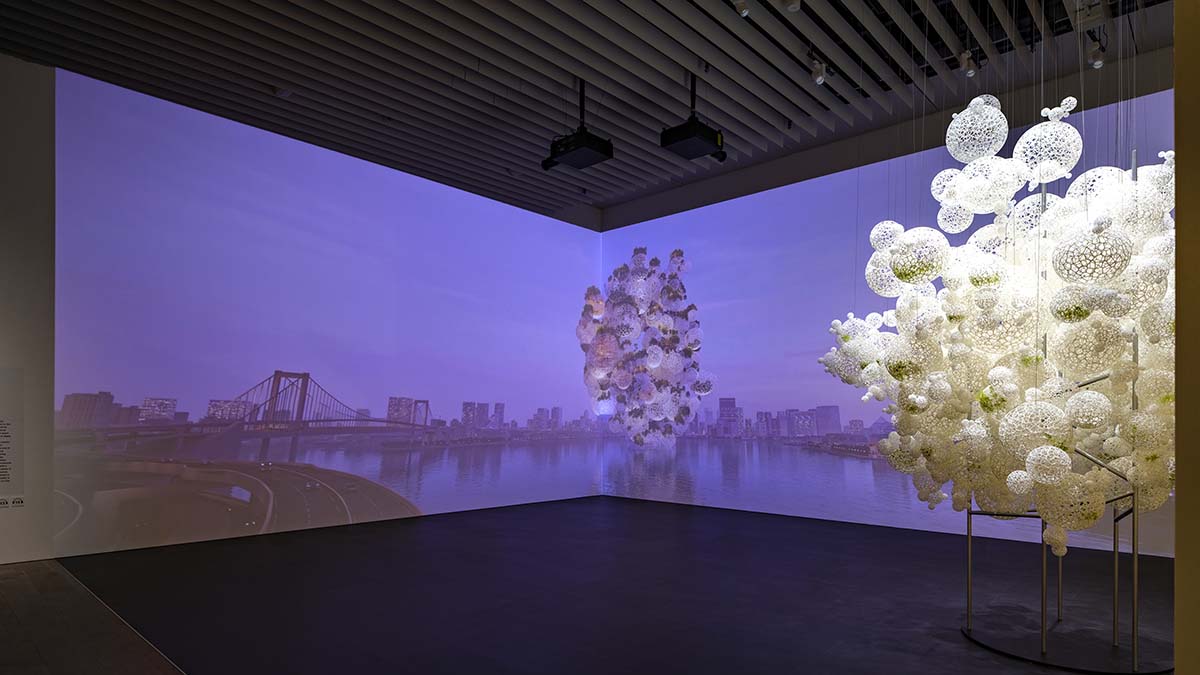
Section 8: Forest of Future, Forest of Primordial – Resonant City 2025. The Architecture of Sou Fujimoto: Primordial Future Forest, Mori Art Museum, Tokyo, 2025. Image © Yashiro Tetsuya, courtesy of Mori Art Museum, Tokyo
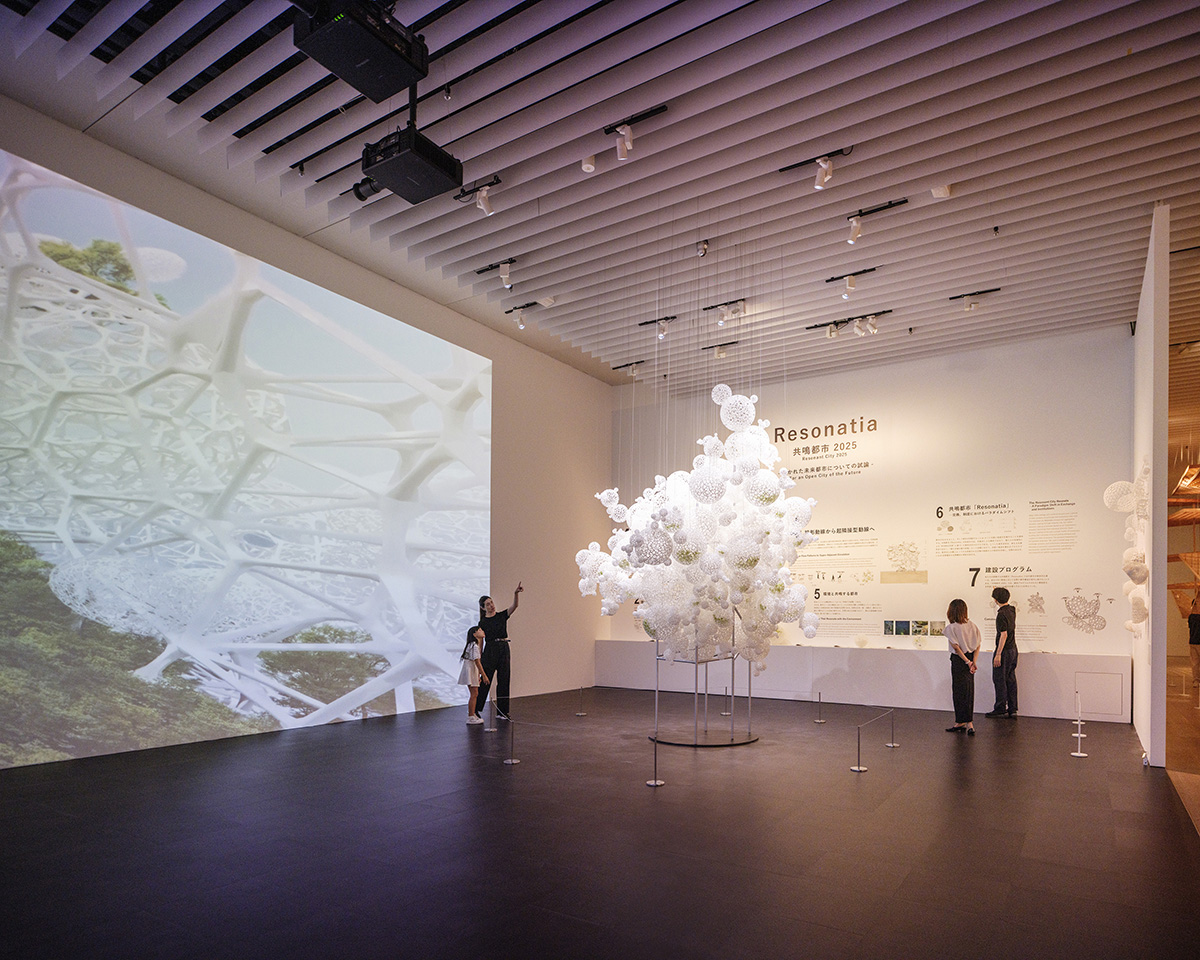
Section 8: Forest of Future, Forest of Primordial – Resonant City 2025. The Architecture of Sou Fujimoto: Primordial Future Forest, Mori Art Museum, Tokyo, 2025. Image © Yashiro Tetsuya, courtesy of Mori Art Museum, Tokyo
8. Forest of Future, Forest of Primordial – Resonant City 2025
Fujimoto and Miyata Hiroaki came up with this idea for a futuristic metropolis. Models and moving pictures depict the city of the future as a complicated conglomeration of spherical structures of different sizes, all within an overall height of roughly 500 meters. It will have all the amenities of metropolitan living, such as offices, schools, and housing. With the spheres opening in many directions to connect with one another in three dimensions, the city lacks an absolute core, much like a forest. This creates a new community model where people are connected in different layers.
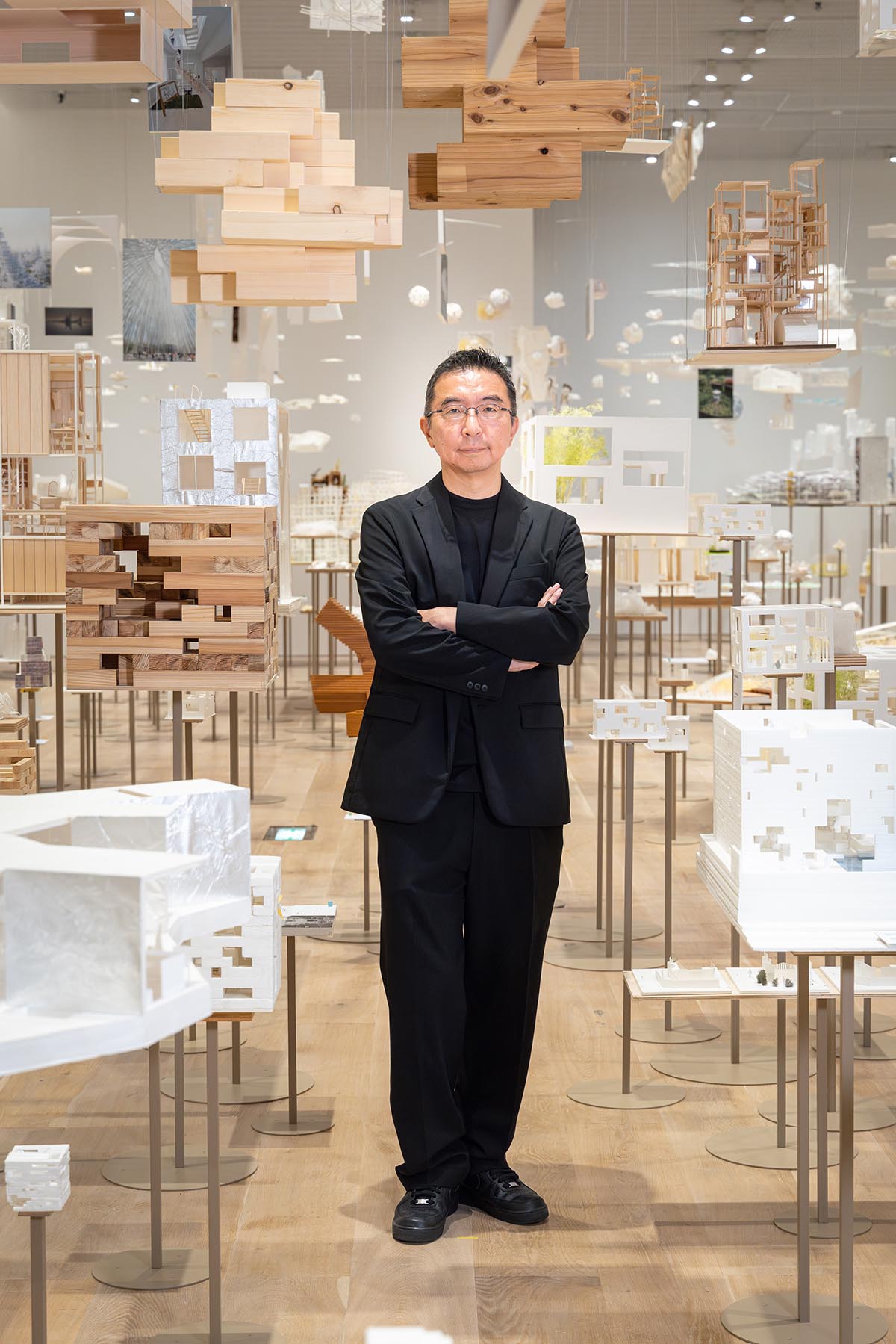
Sou Fujimoto. Image © Tayama Tatsuyuki, courtesy of Mori Art Museum, Tokyo
Born in Hokkaido, Japan, in 1971. After graduating from the University of Tokyo’s Department of Architecture, Faculty of Engineering, he worked on design projects and competitions until founding Sou Fujimoto Architects in 2000. One of his most well-known recent works is L’Arbre Blanc (The White Tree), which won first place in the 2014 International Competition for the Second Folly of Montpellier, France.
He also took first place in a number of international tournaments in different European nations in 2015, 2017, and 2018. He was chosen to be the Expo Site Design Producer for the Japan International Exposition in 2025 (Expo 2025 Osaka, Kansai, Japan).
In 2024, he was selected as the designer of the International Center Station Northern Area Complex in Sendai, Miyagi, Japan, scheduled for completion in 2031.
His notable works include; House of Music Hungary (2021, Budapest), Maruhon Makiart Terrace (2021, Miyagi, Japan), Shiroiya Hotel (2020, Gunma, Japan), L ’ Arbre Blanc (The White Tree, 2019, Montpellier, France), Serpentine Gallery Pavilion 2013 (London), House NA (2011, Tokyo), Musashino Art University Museum & Library (2010, Tokyo), House N (2008, Oita, Japan).
The top image in the article: Forest of Thoughts. Model of 117 projects, study materials, Inkjet print, and others. Dimensions variable. Collection: SHIMIZU CORPORATION (Tokyo) (The Grand Ring for Expo 2025 Osaka, Kansai 1:50 scale model), The Museum of Modern Art, New York (Architecture is everywhere, copy is on view in this exhibition). Image © Yashiro Tetsuya, courtesy of Mori Art Museum, Tokyo.
> via Mori Art Museum
exhibit
exhibition
forest
Mori Art Museum
Sou Fujimoto
Tokyo


AloJapan.com